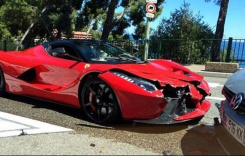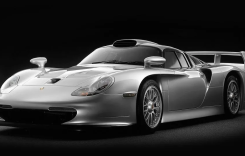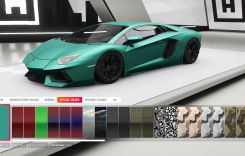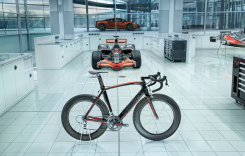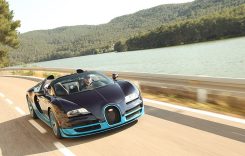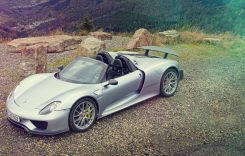It shattered records on Bonneville’s Salt Flats, rumbled to victory on the white sands of Daytona Beach, and climbed up nigh impossible inclines with the abandon of a mountain goat. It has immortalized names like Kretz and Munro in the annals of motorcycle racing history. The weapon of choice of motorcycle racers, hillclimbers, and “Wall of Death” performers alike, the Indian Scout helped forge a company over a 29-year span.
So it is little surprise that Indian Motorcycle Company’s new owners, Polaris Industries, resurrected the middleweight motorcycle. The question wasn’t so much “if” but “when.” On the stage of the biggest motorcycle rally around, the 2015 Indian Scout was introduced to the motorcycling community Saturday night, August 2, the new version hoping to pay homage to its forebears while establishing its own identity.
To accomplish this, Indian Motorcycle Co. used a clean slate, constructing a frame from cast aluminum. Indian designed it so the rear subframe conveniently bolts off, no hacking or welding involved. The cast arms serving as downtubes are dual purpose, shrouding the radiator and supporting the frame. Engineers built a brand-new powerplant for the new Scout, a liquid-cooled, 1133cc, 60-degree V-Twin reportedly putting out 100 horsepower and 72 lb-ft of torque. They gave the engine its own identity with a high level of machining, its inner workings displayed externally. Indian trimmed weight so it tips the scales almost 30 pounds lighter than its chief adversary, Harley-Davidson’s Sportster 1200, and priced it competitively right out of the gate. Then they paid tribute to its heritage when Charlie Ransom of The American Motor Drome Co. rode both a 101 Scout and the 2015 Scout inside the perilous planks of the “Wall of Death.”

Yesterday I rumbled through South Dakota’s Black Hills on the 2015 Scout, spending a little over 100 miles in its saddle. The roads surrounding Sturgis are great testing grounds with its abundance of switchbacks and sweepers. Long, straight stretches allowed me to crack the throttle wide and tap into those 100 ponies Indian kept telling us about. Here’s what I discovered.
The first thing that came to mind when picking it up off the kickstand is “Wow, this thing is light.” It feels much lighter than the Sportster 1200, even more so than the actual 26 pounds that separate the two. Much of that effect is due to a lower center of gravity and a laden 25.3-inch seat height. This theme of lightness carries over to its handling, both in the way it steers to how it transitions smoothly and quickly.
On the straights, I learned the Scout’s engine can be revved higher than most cruiser V-Twins. First gear didn’t tap out until 55 mph, about 10 mph higher than the standard cruiser, and we wound second out to approximately 88 mph before hitting red line. On most cruisers you’re lucky to hit freeway speed in second gear. Acceleration is snappy and it’s quick off the line. A healthy midrange kicks in around 5000 rpm and it continues to give generously up top as I squeezed the powerband for everything it’s got, and even at redline it still tries to rev out instead of sign off.
Tapping into its torque curve is facilitated by a refined gearbox, engagement smooth and fuss-free. No clunk, no thunk, just quiet, efficient engagement. Its clutch lever is taut and the squeeze required midrange. The clutch did slip out of first once, and a couple times it stayed in neutral despite several attempts to kick it in gear from a stop.

Grab a handful of front brake and the twin-pot caliper exerts a solid initial bite. There’s plenty of feel at the front brake lever and stopping power using solely the front is impressive. The rear, with its single caliper clamping down on the 298mm rotor, doesn’t have the same power, but the feel and bite are there. Though the 2015 Indian Scout doesn’t have ABS, it carries its weight low and has less mass than most cruisers, so its braking arrangement never left us wanting.
While the cant of the rear shocks is another of its prominent styling features, the Scout is a little softly sprung for me at 225 pounds. Square a pothole on the front and you’ll feel the bottom of its stroke, though the springs are quick to rebound. The fork tubes are a little spindly while travel on the rear is limited at three inches. At times when accelerating hard out of corners the rear hopped slightly. This most likely could have been remedied with a few twists of a spanner wrench on the adjustable rear but I sampled it in its stock settings during our first ride.
On a wonderfully windy strip of asphalt that dead ends at Silver City, the road twists and turns through 15 mph blind curves and 180-degree bends. The pegs on the Indian Scout allow for a healthy amount of lean with its 5.3 inches of ground clearance. The front end feels light and getting the bike to turn-in takes little coercion at the bars. The Scout flows through turns fluid and stable. Corner exit allows me to tap into that wonderfully potent powerpant. At times, the combination of a lot of power at the back wheel, a 16-inch wheel that’s slim at 150mm, new rubber and dusty roads made the back end squirm on corner exit when we were hot and heavy on the throttle. Its tires are made by Kenda with an assist from Indian on the groove design.
At six-feet-tall, its forward controls left enough room to stretch my legs while its pullback bars are easily at-hand. The seat is low-slung, an enticing selling point for smaller statured riders. I rode comfortable in the saddle all day, a few pressure points at the top of our backside revealing themselves only near the end of our ride. The fact that I didn’t give the seat a second thought until the end of the day means it passes the comfort test.
Its bars are no-nonsense, an analog speedo taking up solo residence between grips. The round instrument gauge features a handful of diagnostic lights in the face and a small digital window where riders can cycle through a tach, oil temp readout, odometer and a single trip meter to go along with a clock. There is a low fuel indicator but no fuel gauge. On the first Scout I sampled, the analog speedo wasn’t working while the digital window with the tachometer and odometer functioned fine. That particular Scout also had a hiccup with fueling. While holding the throttle in one position, the bike would surge slightly before backing off, then surge slightly again before rolling off again. But this was the anomaly instead of the norm because fueling was crisp and spot-on on the second Scout I sampled and no other editors said they experienced the same issue. Indian techs said the first Scout I was on most likely had an issue with its fuel pump.
The 2015 Indian Scout does justice to its namesake. Its got a wealth of power and gearing that maximizes it. Its chassis allows riders to attack corners aggressively, and though its brakes are fairly basic, they’re effective. We wouldn’t mind a little more stiffness to the suspension, but part of that is personal preference because for the majority of the ride it’s well-sorted. Even though its curb weight is listed at 558 pounds, it feels and performs much lighter than that. We’re excited to know they’ll be rolling down a new assembly line in Spirit Lake while its engines will be cranking out of Osceola. It’s a fun bike to ride, and its customizing potential is tremendous. Take notice. Indian Motorcycle Co has fired another salvo at its competition, and the 2015 Indian Scout is an immediate contender for the middleweight cruiser title.

